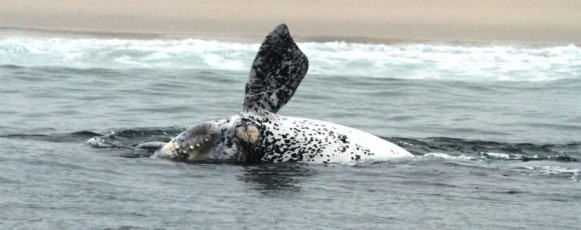Unusual coloration in Cetaceans.
When identifying a species one of the most commonly used characteristics is their colouration. To have unusual skin fur or feather colouration is rare in both humans and animals and can lead to misidentification. Skin, fur and feather colouration is produced by several different pigments, the main one being melanin, and when this is partially lacking, completely absent or over produced different variations of a species normal colour occurs. There are different types of unusual colourations, e.g. albinism, leucism or melanistic. Out of these three, colouration albinism is the most well-known as it occurs when the animals completely lack pigment in their skin, eyes and hair. An albino is easily recognized by their red eyes and often has a high sensitivity to light than individuals without this condition. Leucistic animals have reduced pigmentation and generally have patches of beige or white skin/fur amongst their normal colour. Unlike albinos, leucistic animals have normal coloured eyes. Melanistic animals on the other hand overproduce melanin and turn much darker (generally completely black) than other individuals of the same species. The most well-known example of melanism is the Black Panther, which is in fact a leopard (in Africa) or jaguar (America’s).
In marine animals around 30 different species have been observed with unusual colouring. Amongst the marine mammals, pigmentation abnormalities have been observed in whales, dolphins, porpoises and seals, but never in sea otters or Sirenia. It is commonly, and often incorrectly, assumed that white or pale coloured cetaceans are albinos. There are well-documented reports of an albino sperm whale (Physeter macrocephalus) and bottlenose dolphin (Tursiops truncatus), but most of the white cetaceans are not true albino’s, but rather leucistic. There are two documented records of white Orca’s; one is a male named Iceberg from Russia who is regularly seen among a family pod of 12 other Orca’s, and one in Alaska that was first sighted in 2008.
One of the most famous white cetaceans is Migaloo, so famous he has his own website. He is a humpback whale that can be seen migrating past the Australian east coast. Migaloo were first seen in 1991 and is thought to have fathered two white calves, one of which is named MJ, short for Migaloo Jnr. There is also report of a white humpback whale migrating on Australia’s west coast and three from Norway and Svalbard. Migaloo has not been confirmed as an albino since he doesn’t have a red eye. One of the whales in Svalbard could possibly be albino since photos of it do show a red eye.
Southern right whales exhibit a variety of colouration patterns. They can be almost completely black (normal colour), grey-morph, white blazed or grey blazed. Approximately 3-4% of right whale calves are born partly white, but none of them have been documented with a red eye. Of these calves, most of the body is white, but they have a black collar around the neck and black spots along the body. When they grow older they will turn grey and look more brindle in colour. This happens to the southern right whale because of a recessive gene that affects males (94% of the white calves are male). The chances of a female calf being born white are small. For this to happen a white male needs to impregnate a female with grey patches on her, indicating that she carries the recessive gene that results in the white colouration. This rare colouration has only been documented for southern right whales, not in the northern right whales.
There are 12 records of five different species with melanistic (all-black) colouration. Around New Zealand a humpback whale, bottlenose dolphin and short-beaked common dolphins have been classified as melanistic animals. There is also mention of melanistic Orca’s from Washington state. One well documented case of melanistic marine mammals is for southern right whale dolphins (Lissodelphis peronii) off New Zealand. What’s interesting about this observation was that the four melanistic individuals were travelling together and the only observed calf was seen next to a melanistic adult. This could indicate that after one individual was born melanistic, its offspring’s also became melanistic (this need to be proven with genetic samples).
Abnormal pigmentation can have negative consequences for the animals that have it. These take the form of reduced or increased heat absorption, increased chance of skin diseases, more easily spotted by predators, a potential decrease in their ability to catch prey (if using countershading), increased skin or eye sensitivity and possible problems with visual communication. Despite these problems a lot of abnormally pigmented animals reach adult hood and breeding status.
Ref
http://migaloo.com.au
FERTL D, BARROS NB, ROWLETT RA, ESTES S AND RICHLEN M. 2004. An update on anomalously white cetaceans, including the first account for the pantropical spotted dolphin (Stenella attenuate graffmani). Lat Am J Aquat Mamm 3: 163-166.
Lydersen C. Øien N. Mikkelsen B. Bober S. Fisher D. Kovacs K.M. 2013 A white humpback whale (Megaptera novaeangliae) in the Atlantic Ocean, Svalbard, Norway, August 2012 Polar Research, 32,
FERTL D. AND ROSEL P.E 2008 Albinism In: Perrin, W. F.; Würsig, B. & Thewissen, J. G. M. (eds.) Encyclopedia of marine mammals. 2ª Edition.Academic Press, San Diego. pp.24-26





